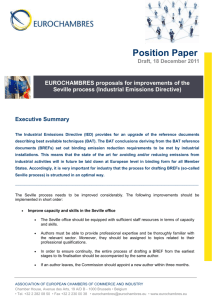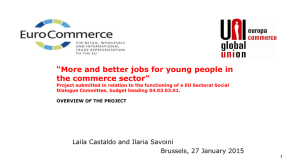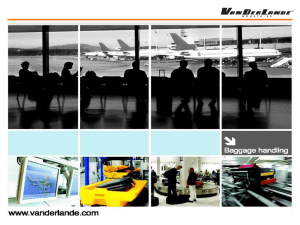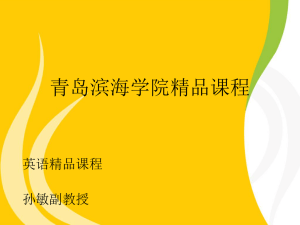EUROCHAMBRES Economic Survey 2015
advertisement
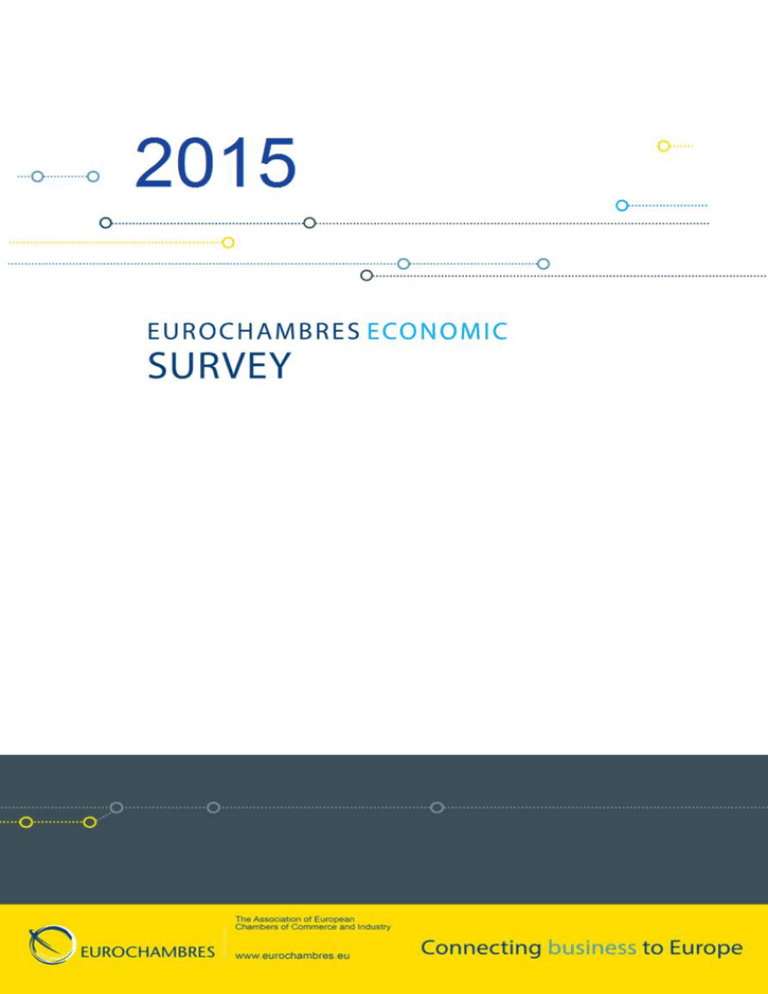
EUROCHAMBRES Economic Survey 2015 Table of contents Foreword............................................................................................................................... 3 Executive Summary .............................................................................................................. 5 Challenges to business confidence ....................................................................................... 6 Trading within and beyond the EU ........................................................................................ 9 Employment Creation.......................................................................................................... 11 Sales and investment .......................................................................................................... 13 Appendix ............................................................................................................................. 17 Methodology .................................................................................................................... 17 Questionnaire .................................................................................................................. 26 Countries participating in survey ...................................................................................... 28 - CLICK THE LOGO TO BRING UP A SUMMARY VIEW OF THE RESULTS - 2 EUROCHAMBRES Economic Survey 2015 Foreword The deep gloom of the 2008-13 period is thankfully less apparent in EUROCHAMBRES Economic Survey (EES) 2015, the 22nd edition of this annual assessment community’s of European expectations for business the year ahead. Nonetheless, the feedback indicates that Europe is not yet out of the woods and that the recovery remains slow. Perennial problems, such as high labour costs, low investor confidence and financing conditions, remain unfavourable in several economies. At the same time, geopolitical tensions with EU trading partners and ongoing obstacles to buying and selling within the EU seem to be turning businesses back towards their national markets, a worrying trend in this era of digital and global opportunities. Several of the EES indicators are of course inextricably linked: investment will not improve unless sales increase and employment will not rise without more investment. Europe’s recovery will be restricted unless policy makers act swiftly, decisively and coherently to address this negative ‘chicken and egg’ pattern. The recent announcement of the European Commission’s Investment Plan for Europe could therefore not be timelier. It is an encouraging signal of the new Commission’s intent and EUROCHAMBRES welcomes the investment stimulation philosophy that underpins it. National governments must be similarly ambitious and innovative in the measures they take to strengthen business confidence, facilitate access to finance, dynamize labour markets, stimulate investment and provide market opportunities. 3 EUROCHAMBRES Economic Survey 2015 EES2015 is a clarion call to leading policy makers for the new EU term to provide the business community with the framework conditions that it requires to drive Europe’s economic recovery. I can assure you that EUROCHAMBRES and the Chamber network will be doing their utmost to ensure that this call is heard clearly and acted upon. Dr Richard Weber President of EUROCHAMBRES 4 EUROCHAMBRES Economic Survey 2015 Executive Summary The EUROCHAMBRES Economic Survey (EES) 2015, based on responses from over 60,000 European businesses, indicates a sluggish economic recovery in most of the 261 countries participating in the survey. All economic indicators show a clear improvement in outcomes during 2014, but apart from domestic demand and employment, the majority of indicators for 2015 slowdown in their rate of growth. The upturn in business confidence of 2014 continues for 2015, but levels vary hugely, with the Iberian peninsula most buoyant while German businesses offer a much gloomier forecast. Exports in 2015 are expected to increase but at a slower pace than in recent years, given the heightened geopolitical tensions and the uncertain global environment. Greece and Turkey stand apart from the rest, registering the greatest expected increase. Domestic sales and employment show encouraging signs of recovery. Portugal is the most optimistic, seemingly anticipating a positive impact from the reform programme. Businesses identify domestic demand, foreign demand and economic policy conditions as the hardest challenges to cope with. Access to finance remains a major concern for business sector’s growth, contributing to the stagnation of investment expectations. As ever, the results vary considerably across countries, but, being overall in line with the recent European Commission forecasts2, they paint a picture of modest growth. 1 For a complete list of participating countries is consult the Appendix European Economic Forecast, Autumn 2014 http://ec.europa.eu/economy_finance/publications/european_economy/2014/pdf/ee7_en.pdf 2 5 EUROCHAMBRES Economic Survey 2015 Challenges to business confidence Challenges ahead Respondents to EUROCHAMBRES Economic Survey (EES) 2015 were asked to identify up to three challenges respectively faced during 2014 and that they anticipate as being the most significant in 2015.3 Domestic demand remains constrained and far from the pre-crisis level and needs further support, as reflected in its prominence among the challenges identified in EES2015, both for 2014 and 2015.4 Many report difficulties in coping with general economic policy conditions. This confirms that, apart from specific issues that create challenges for individual businesses in particular sectors or areas of activity, entrenched economic obstacles to productivity and competitiveness remain. Two other persistent issues of concern for businesses- financing conditions and labour costsfeature strongly among the challenges for the year ahead. Addressing these challenges 3 Respondents were asked to select up to 3 from a list of 8 challenges, without ranking their selection. The list of 8 challenges can be seen in the EES2015 questionnaire in the Appendix 4 Graphs of the ‘challenges’ question are available in the Appendix 6 EUROCHAMBRES Economic Survey 2015 effectively will be a key factor in the new EU leadership’s ability to steer Europe towards recovery. Business Confidence The EUROCHAMBRES Economic Survey business confidence indicator5 captures respondents’ general sentiment about their prospects for the year ahead, reflecting their level of optimism. EES2015 reveals that business confidence for the year ahead remains roughly at the same level of 2014. This result is in line with the European Commission’s estimations and reflects an overall decline in business confidence in the second semester of 2014. Business Confidence in EU 40 120 30 115 10.57 10 110 105 100 0 95 -10 90 -20 85 -30 80 -40 75 -50 Index (unit=100) Weighted index 20 70 2005 2006 2007 2008 2009 2010 2011 Business Confidence 2012 2013 2014 2015 Economic Sentiment Indicator Source: Economic Sentiment Indicator, European Commission. Business Confidence, EUROCHAMBRES Concerns over both domestic demand and trading conditions, fuelled notably by RussiaUkraine tensions, along with frustrations at the pace of structural reforms and uncertainty about global growth, contribute to the levelling out in business confidence. Perennial constraints, such as high labour costs and difficulties in accessing credit or other forms of 5 Indicates how optimistic or pessimistic businesses are for the coming year, effectively giving a sense of what the general feeling of businesses in the participating countries will be is for 2015 7 EUROCHAMBRES Economic Survey 2015 financing, should also be factored into the business community’s fairly cautious outlook for 2015. Business Confidence and Real GDP Growth in EU 40 4 2 Weighted index 20 10.57 10 7.39 0 -10 0 -2 -20 -30 -4 real GDP growth rate 30 -40 -50 2005 2006 2007 2008 Business Confidence Forecast -6 2009 2010 2011 2012 2013 2014 2015 Business Confidence Outcome GDP growth (EU 28) Source: Real GDP growth rate, volume, percentage year-on -year change, year 2015- forecast, EUROSTAT. Business Confidence Index, EUROCHAMBRES The picture varies considerably between countries: Portugal and Spain, economies which have undertaken ambitious reform programmes, displayed a significant increase in business confidence, while extremely low inflation and concerns relating to tensions with Russia have led to a much gloomier prognosis by German businesses. After a surprisingly subdued performance during 2014, Germany has revised further downward their expectation for 2015, dropping approximately five-fold, from 31 to 6. The most optimistic businesses can be found in Montenegro, with an index of 55.5, while the most pessimistic are in Austria, with a descending indicator of -40.7, and Slovakia, with an index of -34.4. Austria and Slovakia have been consistently pessimistic in the previous three years, displaying the lowest variation over time between forecasted and realised values. The average index for the period 2012-2015 is respectively equal to -34.2 and -43. Conversely, Turkey has been the most optimistic over the medium term, registering the highest average of 38.8 during the period 2012-2015. Overall, although still above the levels recorded at the peak of the crisis, this deceleration in the improvement of business confidence is a cause for concern. 8 EUROCHAMBRES Economic Survey 2015 Trading within and beyond the EU Export sales 6 30 in confirming 20 expectations. This growth 10 2014, has mainly been driven by Index Exports steadily increased -10 countries, whereas in the -20 Euro Area, export sales -30 remained and roughly 22.88 0 candidate non-Euro 25.82 2005 2006 2007 2008 2009 2010 2011 2012 2013 2014 2015 stable EES average EURO area from 2013. For 2015, conversely to recent years when trade was the beacon of hope, European businesses are relatively cautious about export Box 1: Voice of entrepreneurs sales. Businesses are still hindered by the many remaining barriers to the EU single market, despite its theoretical completion over 20 years ago. They are now also increasingly concerned During the European Parliament of Entrepreneurs, European businesses clearly expressed their wish to move towards a more integrated EU single market and a about the impact of the complex geo-political stronger situation in some of the EU’s neighbouring Diplomacy on the global stage. European Economic countries, the EU-Russia trade sanctions and embargos, as well as contracting global growth prospects, all of which is holding back export projections for next year. 6 Demonstrates businesses' expectations regarding the growth or decrease in sales beyond the national border, whether that is within the EU single market or towards third countries 9 EUROCHAMBRES Economic Survey 2015 After a fall in exports in 2014, Hungarian businesses expect a further contraction in 2015. Greece7 expects a sharp surge in export Box 2: Did you know that… After 6 years of economic sales, with an index increase from 11.5 recession, Greece seems to be to 36.5, finally revealing early signs of an turning the corner. Available data economic upturn. indicates Portugal and Spain improved their export balance will be positive. However, performance while exports of goods, sustained by during 2014: Portugal increased its index by 27%, reaching 65 points, its highest since 2005, and Spain by 60%, achieving an index of 59. These positive performances corroborate the recent surge in optimism the that euro’s exceeded exports the trade depreciation, the of 2014 pre-crisis services have levels, are still subdued, 25% below the pre-crisis level. about prospects for the Spanish and Portuguese economies, which seem to be starting to feel the benefits of several years of extensive reforms. 7 Data from OECD international trade database http://data.oecd.org/trade/trade-in-services.htm#indicator-chart 10 EUROCHAMBRES Economic Survey 2015 Employment creation High unemployment is one of the most striking and damaging legacies of the crisis. While remaining a major socio-economic challenge, employment levels8 among EES respondents picked up during 2014 in all of the surveyed countries and this positive trend is set to continue in 2015. After a fall in 2013, the indicator performed much better than expected in 2014, climbing from -9.1 to 2.7. For 2015, firms have revised their expectations upwards, with a positive index of 7.1 across the EES. Nonetheless, the level of improvement anticipated is tentative. Elsewhere in the EES, labour costs are identified among the key challenges for the year ahead. This area clearly remains a priority for reforms if minor improvements in employment levels are to accelerate significantly. 20 2 15 1.5 10 5.21 1 5 0.5 0 0 -5 -0.5 -10 -1 -15 -1.5 -20 Growth rate Weighted index Employment Forecast, Outcome and Employment Growth -2 2005 2006 2007 2008 2009 2010 2011 2012 2013 2014 2015 Employment Forecasts Employment Outcome Employment growth Source: Annual percentage change in total employment population EUROSTAT. Labour Index, EUROCHAMBRES 8 Indicates whether businesses plan to employ more or less people than in the current year 11 EUROCHAMBRES Economic Survey 2015 Indeed, given low levels of business confidence, high unemployment, especially amongst young Box 3: Voice of entrepreneurs generations, remains a concern and a priority for most countries. The fragile rebound in the During the European Parliament of labour market is uneven, with unemployment forecasts diminishing overall, but Enterprises, businesses called for varying stronger considerably across countries. EU engagement in enhancing skills and training of workers: 99% of voters expressed Estonia9 confirms its long term positive their support for reforms to work- performance, with an employment index based of 18.9 in 2014 and 30 in 2015. Apart supported learning; the 93% of creation them of a European mobility programme for from a dramatic slump in 2009 due to job seekers. the crisis, Estonia stands out for its consistent and above average employment figures. Southern European countries such as Spain and Portugal show increasing signs of recovery. The employment index for Spanish firms surpassing its improved pre-crisis markedly, level and Since the early 90s, Estonia has reaching a peak in 2014 of 14 points. Portuguese business outcomes made the digital agenda one of its were main priority, building an efficient above expectations for 2014 and the 2015 Box 4: Did you know that… system of e-government and index is 34.5. Given the rigidity of their pursuing labour markets, much effort still needs to policies. Today, its hi-tech sector be done, as recent growth is not yet counts for more than 15% of GDP; it making up for the weak recovery. is global leader in number of start- Greece’s labour market is still struggling ups per person, developing a highly and concentrated cluster of globally- EES2015 provides no oriented start-ups. encouragement: the index has been constantly below zero since 2009 technology-oriented and forecasts for 2015 at -1.7 are set to maintain this worrying pattern. 9 Box 4: Data on come from World Bank's Entrepreneurship Survey and database http://econ.worldbank.org/research/entrepreneurship 12 EUROCHAMBRES Economic Survey 2015 Sales and investment Domestic demand Although still far below levels, witnessed revival a in Domestic sales 2014 modest domestic 10 sales . After four years of negative outlook, 2014 domestic sales increased on average by 16 points Index pre-crisis 40 30 20 10 0 -10 -20 -30 -40 10.6 6.3 2005 2006 2007 2008 2009 2010 2011 2012 2013 2014 2015 and a further rise of 25% EES average EURO area is predicted for 2015. In the Euro area, the index performed better, jumping from -27.3 in 2013 to -0.6 in 2014, while in 2015 it is expected to increase further to 6.3. However, sales to domestic purchasers, which provide a measure of underlying demand, are still depressed in much of Europe, so even taking into account these optimistic increases, there remains considerable scope Box 5: Did you know that… for improvement. There All countries expect an increase in private recovery consumption, even if moderate, and private projected to benefit the most from investment. This should boost domestic sales and have a positive knock-on effect on are in signs Spain. of economic SMEs are improved availability of credit. Many initiatives in this area are supported by the Chamber network, such as investment. the project Aprende a financiarte, which targets companies in need of Greece is the only country in which funds providing support and help. domestic demand is set to remain 10 Shows businesses' predictions regarding growth or decrease in sales of their products within the national borders 13 EUROCHAMBRES Economic Survey 2015 subdued, reflecting the country’s still unsteady path out of the crisis. In 2014 domestic sales recovered somewhat, slightly improving to -5.6 point, but they are expected to lose ground again in 2015 and fall to the 2013 level of -30.6. In the Baltic States, domestic demand is helping to ensure growth and both the 2014 outcome and 2015 forecasts are above the EES average. As with several other EES2015 indicators, domestic sales improvements indicate economic recovery in Portugal and Spain as the deep structural adjustment starts to bear fruit. Portugal expects a big surge in sales next year, while Spain has posted the greatest increase among all large Eurozone countries, with a rise in the index from 30 in 2013 to 14 in 2014. Given the importance of domestic demand to boost economic growth, these optimistic figures are sources of encouragement. Nonetheless, it must be remembered that these improvements are based on a historically low starting point of 2012 and 2013. This, together with the fact that domestic sales are also identified in the survey as a potential challenge for 2015, demonstrate that policy makers must make a concerted effort in the year ahead to stimulate demand across Europe and to give solid foundations to the internal market. 14 EUROCHAMBRES Economic Survey 2015 Investment Investment Investment levels 30 depend on domestic demand 20 and 10 are also affected by a number of other factors, Index domestic sales, but 8.02 5.47 0 -10 notably -20 access to finance and the general economic outlook. -30 2005 2006 2007 2008 2009 2010 2011 2012 2013 2014 2015 EES average EURO area Businesses’ positive investment expectations for 2014 were met according to EES2015: investment levels 7.86 reached the highest value since 2007. However, it seems that this momentum may not be maintained in 2015 as businesses expect a similar level of investment for the year ahead: still higher than for the post-crisis period as a whole, but below the level needed for a robust economic recovery. Investments are likely to suffer from the businesses’ limited ability to acquire bank loans. Banks are not yet loosening their credit standards despite the accommodating monetary policy of the European Central Bank. As underlined in responses to the EES question on challenges during the previous year, severe financing conditions undermined the business community’s recovery in 2014. Low levels of investment restrict firms’ productivity and competitiveness, which in turn has a negative effect on the internal market, currently characterised by weak levels of demand. The contraction in investment has to be seen as the primary reason for the weak recovery: as shown by the EES results, the predicted figure for 2015 is still more than 10 points lower than its pre-crisis level. 15 EUROCHAMBRES Economic Survey 2015 Business expectations for investment for 2015 vary greatly between countries. The Baltic States have registered a consistently positive outlook since 2012, always meeting their expectations: their internal market is strengthening, as the data on domestic sales and private consumption corroborate. Since 2005, they have historically recorded above-average levels of investment, dipping dramatically only in 2009 before rapidly returning to a high trend. Candidate countries (Turkey, Montenegro, Serbia) also performed quite well in recent years, as they did not suffer directly from the same challenges as Euro area businesses, such as protracted mediocre growth and persistently low inflation. Regulatory uncertainties, along with banks’ effort to deleverage their balance-sheets ahead of the AQR and the ECB stress tests, mean that European businesses continue to encounter a Box 6: Voice of entrepreneurs At the October 2014 European Parliament of Enterprises results, dramatic shortfall in options from a stubbornly 75% of businesses registered that fragmented European financial market. access to finance has become more difficult due to increased regulatory The micro perspective described by private costs for the banking sector. businesses and the macro one presented by policy makers describe the same phenomenon through two different lenses: as long as financing solutions remain unavailable to the private sector, the level of investment required to drive a more sustained and robust recovery will be out of reach. 16 EUROCHAMBRES Economic Survey 2015 Appendix Methodology About the Survey EUROCHAMBRES Economic Survey (EES) is an annual qualitative survey of business expectations in Europe. The survey is implemented by the Chambers of Commerce and Industry and co-ordinated by EUROCHAMBRES and is now in its 22nd year. It is based on a harmonised questionnaire sent to business owner-managers from EU member states as well as to EU candidate countries: Serbia, Turkey and Montenegro. The questionnaire focuses on five economic indicators: business confidence, domestic sales, exports, employment and investment and also includes two questions on challenges. For EES2015, over 60 000 businesses responded during early autumn 2014. Data has been aggregated at national level and weighted according to the respective 2013 GDP to obtain EU estimates. Implementation Chambers of Commerce and Industry in Austria, Belgium, Bulgaria, Croatia, Cyprus, the Czech Republic, Estonia, Finland, Germany, Greece, Hungary, Italy, Latvia, Lithuania, Luxembourg, Malta, Montenegro, the Netherlands, Portugal, Romania, Slovakia, Slovenia, Spain, Serbia and Turkey have posed companies a set of 12 questions on their past and future expectations. Business owner-managers were asked to give a comparative response, i.e. “better than the previous year”, “the same as the previous year” or “worse than the previous year” to two questions per indicator: one on the outcomes of 2014 as compared to the previous year, and one on expectations for 2015. Responses from entrepreneurs were collected and aggregated at national level according to official regional GDP. At European level, results were weighted according to national GDP. Weighted averages were used to guarantee representativity by size and region. 17 EUROCHAMBRES Economic Survey 2015 Results are a balance figure, obtained by deducting the percentage of companies giving a negative response from the percentage of companies giving a positive response, thereby obtaining the 'net positive response'. Analysis of the results was based on input from national Chambers, as well as on various external sources. In the case of Finland, an alternative methodology was followed: rather than questionnaires being sent to businesses, they were answered by Chambers of Commerce and Industry at regional level, and then aggregated at national level according to regional GDPs. Answers were based on Chamber analysis and conclusions regarding the outcomes in 2014 and 2015 expectations for businesses. Results for the Netherlands are provided following a slightly different procedure: businesses were asked about their sentiments for 3Q 2014, which were then treated as proxy for 2014 annual data. 18 EUROCHAMBRES Economic Survey 2015 Tables Figure 1: EUROCHAMBRES Economic Survey results on Challenges Challenges for 2014 Economic policy conditions Domestic demand Financing conditions Foreign demand Prices of energy and raw materials Exchange rates Labour costs Lack of skilled workers Shares are calculated as % of the total number of respondents Challenges for 2015 Economic policy conditions Domestic demand Financing conditions Foreign demand Prices of energy and raw materials Labour costs Exchange rates Lack of skilled workers 19 Shares are calculated as % of the total number of respondents EUROCHAMBRES Economic Survey 2015 Figure 2: EUROCHAMBRES Economic Survey results over the years 2005-2015 Index of Business Confidence (weighted average) 40 30 20 10 0 -10 -20 -30 -40 2005 2006 2007 Business confidence 2008 2009 2010 Domestic sales 2011 Export sales 20 2012 Employment 2013 2014 Investment 2015 EUROCHAMBRES Economic Survey 2015 Figure 3: Business confidence per country (2013-2015) 70 50 Index (weighted average) 30 10 -10 -30 -50 -70 -5.3 -20.5 27.0 -47.1 30.4 -23.2 28.0 42.0 -28.1 13.9 0.0 EES Avera ge -11.0 -27.7 21.4 -33.9 -58.3 -34.9 -30.0 39.0 -2.5 2014 -40.7 -2.3 5.7 -30.2 -16.3 27.3 -34.5 -61.9 31.0 -47.1 -13.9 -12.8 51.5 26.9 -20.2 11.8 55.5 -1.9 -13.5 12.1 -11.1 -34.4 -16.5 12.0 39.0 7.4 2015 -37.9 19.5 24.8 60.6 -20.2 23.3 44.2 0.0 36.0 10.6 AT BE BG HR CY CZ 2013 -31.2 -0.2 -10.9 -34.8 -62.8 -9.5 9.7 6.5 EE FI 20.9 -20.1 -0.2 DE 6.0 EL HU -12.4 -11.4 IT 3.3 LV 20.0 21 LT LU MT ME NL PT 62.6 RO 32.7 RS SK SI ES 46.7 -23.0 -18.7 38.0 TR EUROCHAMBRES Economic Survey 2015 Figure 4: Export sales per country (2013-2015) 100 80 Index (weighted average) 60 40 20 0 -20 -40 -60 AT BE BG HR CY CZ EE FI DE EL 2013 2.9 10.0 19.1 -15.6 -7.8 3.1 2014 5.8 11.5 10.8 -7.7 5.5 10.5 17.3 -14.3 0.0 17.4 23.0 2015 -6.5 25.2 38.9 15.4 16.7 -1.0 38.4 -53.9 15.0 85.7 LU MT ME NL PT RO RS SK SI ES 31.8 0.5 13.8 0.0 3.1 51.9 16.8 7.6 26.2 14.9 37.0 EES Avera ge 29.0 20.4 15.3 10.6 -0.6 -50.0 6.6 17.4 -3.8 9.1 26.2 44.9 44.0 41.0 24.4 32.3 12.4 19.0 18.3 65.9 17.7 52.3 31.1 49.4 59.0 34.0 25.8 HU IT LV LT 11.5 7.6 25.0 60.0 11.5 -9.2 26.4 27.3 36.7 -17.0 40.9 54.5 22 -3.8 TR EUROCHAMBRES Economic Survey 2015 Figure 5: Employment per country (2013-2015) 60 Index (weighted average) 40 20 0 -20 -40 -60 AT BE BG HR CY CZ 2013 -6.1 -0.5 2.3 -2.6 -56.5 -7.2 2014 -6.7 8.9 4.8 -5.4 -0.1 9.3 2015 -27.6 11.5 18.1 9.3 0.0 4.0 EE FI DE EL HU 14.4 -30.8 0.0 -19.6 0.0 -22.1 -15.0 18.5 18.9 -55.8 4.0 -19.6 0.0 -13.7 24.2 1.6 30.0 2.0 -1.7 -11.0 -9.5 8.0 6.3 -4.7 IT LV 33.3 23 LT LU MT ME NL PT 7.1 5.3 0.0 10.1 16.2 3.8 1.8 7.0 17.5 42.3 1.7 34.5 17.2 -12.9 -15.5 RO RS 0.3 3.8 34.0 6.7 11.1 SI ES TR 0.0 EES Avera ge -16.4 -20.0 34.0 -9.1 -3.3 32.6 14.0 36.0 2.8 3.3 8.1 22.0 40.0 5.2 SK EUROCHAMBRES Economic Survey 2015 Figure 6: Investment per country (2013-2015) 60 Index (weighted average) 40 20 0 -20 -40 -60 AT BE BG HR CY CZ EE FI DE EL HU IT LV 2013 -14.6 3.9 -0.4 -13.6 -53.9 -10.3 17.3 -10.3 0.0 -12.5 16.3 -12.1 29.0 2014 -16.2 5.3 11.6 -14.3 -19.0 3.9 13.0 48.7 8.0 -12.5 -3.6 25.2 5.8 27.1 -55.4 8.0 2015 -24.3 12.5 23.8 -3.8 0.1 -13.9 LT LU MT ME NL PT RO RS EES Avera ge 22.6 -31.8 -16.0 28.0 -3.5 SK SI ES TR 29.1 3.4 24.5 0.0 -7.8 4.8 8.8 8.8 5.4 51.5 21.6 7.5 29.8 38.1 6.1 10.5 2.0 24.4 4.9 23.2 8.0 25.0 7.9 7.6 36.4 27.9 7.9 32.5 53.1 5.8 45.0 29.3 9.1 27.9 34.8 10.0 26.0 8.0 24 EUROCHAMBRES Economic Survey 2015 Figure 7: Domestic sales per country (2013-2015) 80 60 Index (weighted average) 40 20 0 -20 -40 -60 -80 2013 -11.2 1.8 2.4 1.9 -72.5 -23.0 22.1 -26.8 -30.3 36.5 -38.3 -58.0 34.6 6.0 2.5 0.0 -28.9 -2.9 9.9 21.4 -36.9 -30.0 EES Avera ge 50.0 -13.5 2014 -15.2 8.8 -4.4 -10.5 -0.3 11.0 18.0 -14.2 -5.6 -3.9 -13.6 48.5 34.2 11.5 -3.3 25.0 5.3 22.1 22.2 19.7 25.9 14.0 44.0 3.0 2015 -19.2 20.8 9.8 23.8 0.0 5.3 23.3 45.8 -30.3 -17.0 -2.8 60.6 35.1 13.3 13.6 34.6 67.8 39.7 57.8 9.8 15.0 37.0 47.0 10.6 AT BE BG HR CY CZ EE FI EL HU IT LV 25 LT LU MT ME PT RO RS SK SI ES TR EUROCHAMBRES Economic Survey 2015 Questionnaire CHALLENGES LABOUR Q.1 Compared with 2013, the biggest Q.7 Compared with 2013, the size of our challenge(s) for the economic development workforce in 2014 has: of our company in 2014 was (max. 3 answers possible): Q.2 Domestic demand Increased Remained constant Decreased Foreign demand Labour costs Lack of skilled workers Exchange rates Price of energy and raw materials Financing conditions Economic policy conditions We expect that the biggest Q.8 We expect that during 2015 the size of challenge(s) for the economic development our workforce will: of our company in 2015 will be (max. 3 answers possible): Domestic demand Foreign demand Labour costs Lack of skilled workers Exchange rates Price of energy and raw materials Financing conditions Economic policy conditions 26 Increase Remain constant Decrease EUROCHAMBRES Economic Survey 2015 NATIONAL SALES INVESTMENT Q.3 Compared with 2013, our revenue Q.9 Compared with 2013, our level of from national sales in 2014 has: investments in 2014 has: Increased Remained constant Decreased Increased Remained constant Decreased Q.4 We expect that our revenue from Q.10 We expect that during 2015 our level national sales in 2015 will: of investments will: Increase Remain constant Decrease Increase Remain constant Decrease EXPORT SALES BUSINESS CONFIDENCE Q.5 Compared with 2013, our revenue Q.11 from export sales in 2014 has: developments for our business in 2014 Compared with 2013, overall were: Increased Remained constant Decreased Favourable Remained constant Unfavourable Q.6 We expect that our revenue from Q.12 We expect that during 2015, overall export sales in 2015 will: developments for our business will be: Increase Remain constant Decrease 27 Favourable Remain constant Unfavourable EUROCHAMBRES Economic Survey 2015 Abbreviations for countries participating in survey Abbreviations (EU countries arranged in alphabetical order) AT Austria BE Belgium BG Bulgaria HR Croatia CY Cyprus CZ Czech Republic EE Estonia FI Finland DE Germany EL Greece HU Hungary IE Ireland IT Italy LV Latvia LT Lithuania LU Luxembourg MT Malta ME Montenegro NL Netherlands PT Portugal RO Romania SK Slovakia SI Slovenia ES Spain RS Serbia TR Turkey 28 EUROCHAMBRES Economic Survey 2015 Participating Chambers of Commerce and Industry Austria Austrian Federal Economic Chamber Christoph Haushofer, (+43) 05 90 900 4280 christoph.haushofer@inhouse.wko.at Claudia Huber claudia.huber@wko.at Belgium Federation of Belgian Chambers of Commerce Antonio Giromini, (+32) 02 209 0552 agiromini@belgianchambers.be Bulgaria Bulgarian Chamber of Commerce and Industry Olga Chugunska, (+35) 92 8117 411 ikan@bcci.bg Croatia Croatian Chamber of Economy Dubravka Zubak dzubak@hgk.hr, makroekonomija@hgk.hr Jasna Belošević Matić, (+38) 50 148 28373 jbelosevic@hgk.hr Cyprus Cyprus Chamber of Commerce and Industry Leonidas Paschalides, (+35) 72 288 9840 leonidap@ccci.org.cy 29 EUROCHAMBRES Economic Survey 2015 Czech Republic Czech Chamber of Commerce Petr Valenta, (+42) 02 667 21417 valenta@komora.cz Estonia Estonian Chamber of Commerce and Industry Marko Udras, (+37) 2 604 0060 Marko.Udras@koda.ee Finland Finland Chamber of Commerce Anne Hatanpää, (+35) 8 9 4242 6261 anne.hatanpaa@chamber.fi Germany Association of German Chambers of Industry and Commerce Dirk Schlotböller, (+49) 030 20308 1504 schlotboeller.dirk@berlin.dihk.de Greece Union of Hellenic Chambers of Commerce Vassilis Apostolopoulos, (+30) 2103387104-6 vassapost@uhc.gr Hungary Hungarian Chamber of Commerce and Industry Agnes Mako, (+36) 12 35 0584 agnes.mako@gvi.hu 30 EUROCHAMBRES Economic Survey 2015 Italy Union of Italian Chambers of Commerce, Industry, Craft and Agriculture Domenico Mauriello, (+39) 06 470 4513 domenico.mauriello@unioncamere.it Ilaria Cingottini Ilaria.Cingottini@unioncamere.it Latvia Latvian Chamber of Commerce and Industry Elīna Bičevska elina.bicevska@chamber.lv Janis Butkevics janis.butkevics@chamber.lv Lithuania Association of Lithuanian Chambers of Commerce, Industry and Crafts Asta Cekelyte, (+370) 5 261 21 02 info@chambers.lt Luxembourg Chamber of Commerce of the Grand Duchy of Luxembourg Christel Chatelain, (+35) 242 39 39 358 christel.chatelain@cc.lu Malta Malta Chamber of Commerce, Enterprise and Industry Andre Fenech, (+35) 622 032 312 andre.fenech@maltachamber.org.mt 31 EUROCHAMBRES Economic Survey 2015 Montenegro Chamber of Economy of Montenegro Ksenija Dukanović (+382) 20 231 006 kdjukanovic@pkcg.org Tanja Radusinović tradusinovic@pkcg.org Netherlands Netherlands Chamber of Commerce Ivo de Jong, (+31) 651 594 445 ivo.de.jong@kvk.nl Portugal Portuguese Chamber of Commerce and Industry João Paes Cabral, (+351) 21 322 4050 jpc@acl.org.pt Romania Chamber of Commerce and Industry of Romania Petru Russu petru.russu@ccir.ro Petru Saca petru.saca@ccir.ro Slovakia Slovak Chamber of Commerce and Industry Katarína Hvizdošová, +421 2 54433846 katarina.hvizdosova@sopk.sk 32 EUROCHAMBRES Economic Survey 2015 Slovenia Chamber of Commerce and Industry of Slovenia Alenka Avberšek alenka.avbersek@gzs.si Bojan Ivanc bojan.Ivanc@gzs.si Spain Chamber of Commerce of Spain Manuel Valero, (+34) 91 590 69 00 manuel.valero@cscamaras.es Serbia Chamber of Commerce and Industry of Serbia Snezana Raseta, (+38) 111 3248 349 snezana.raseta@pks.rs Dragana Camagic dragana.camagic@pks.rs Turkey Union of Chambers and Commodity Exchanges of Turkey Cagri Gurgur, (+90) 312 218 2610 cagri.gurgur@tobb.org.tr Thank you also for their valuable comments to 33 EUROCHAMBRES Economic Survey 2015 EES2015 Editorial Committee Ben Butters (EUROCHAMBRES) Elisa Facchetti (EUROCHAMBRES) Iwona Mertin (EUROCHAMBRES) Dirk Schlotböller (Association of German Chambers of Industry and Commerce) Recommended links EUROCHAMBRES Economic Survey 2015 Infographic European Parliament of Enterprises 34
